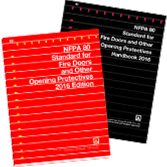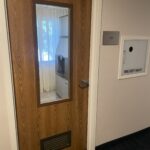 I’ve been working on updating my code reference guide – adding new information from the 2016 edition of NFPA 80 – Standard for Fire Doors and Other Opening Protectives. There are quite a few changes to NFPA 80, and although this edition of the standard won’t be used in most jurisdictions until the 2018 model codes are adopted, some of the changes may help to clarify the requirements of previous editions.
I’ve been working on updating my code reference guide – adding new information from the 2016 edition of NFPA 80 – Standard for Fire Doors and Other Opening Protectives. There are quite a few changes to NFPA 80, and although this edition of the standard won’t be used in most jurisdictions until the 2018 model codes are adopted, some of the changes may help to clarify the requirements of previous editions.
I’ll be writing more in-depth articles in the coming months, but here are some of the highlights…
4.1.3 Appurtenances – This section addresses preparations for hardware, including job-site preparations. For as long as I can remember, job-site preparations have been limited to a maximum of 1-inch diameter round holes (cylinder holes may be any size), 3/4-inch undercutting of wood and composite doors, and installation of protection plates. The 2013 edition of NFPA 80 addresses other field modifications in section 5.1.4. The 2016 edition states that field-drilled holes larger than 1 inch are permitted for surface-applied hardware when allowed by the listings of the door and hardware manufacturer. This section of the 2016 edition also allows field-drilled raceways for wires when allowed by the door manufacturer and the listing laboratory.
4.1.4 Signage – In previous editions, this section does not allow signage to be attached to glazing in a fire door assembly, but in some cases there isn’t enough space on the door for the required delayed egress lock signage. The 2016 edition of NFPA 80 prohibits signage installed on fire-protection-rated glazing. I interpret this to mean that the signage could be installed on fire-resistance-rated glazing. It’s a costly option, but at least it’s an option.
4.2 Listed and Labeled Products – This section now includes a list of information required on labels for fire doors, fire door frames, and fire windows. There are a couple of new paragraphs that I need to get clarification on (what do you think the intent is?)…
- 4.2.1.4.1 Fire door frames rated at 3 hours when installed with masonry anchors in masonry walls or rated at 1 1∕2 hours when provided with wood stud or steel stud anchors and installed in gypsum board walls shall not be required to be provided with a fire protection rating.
- 4.2.1.4.2 In lieu of 4.2.1.4.1, fire door frames shall be marked with the label or embossment of the third-party certification agency and the manufacturer’s name or a code that can be traced back to the manufacturer.
4.8.4 Clearance – In the 2016 edition, this section references products designed to address fire doors with a clearance of more than 3/4-inch at the bottom. As I’ve said before, products installed to bring these doors into compliance must be listed for this purpose – a standard door sweep is not sufficient.
5.1.4 Field Labeling – A new section has been added to address field labeling of fire door assemblies, including requirements for the individuals or companies doing the labeling, proof of their qualifications, and the information that must be included on the field labels. It also addresses modifying a non-fire-rated assembly to achieve a fire rating.
6.3.1.7 Clearances – In previous editions of the standard, clearances at the head, jambs, and meeting stiles of fire doors were limited to 1/8-inch with a tolerance of plus or minus 1/16-inch for hollow metal doors, and 1/8-inch maximum for wood doors. In the 2016 edition, the 1/16-inch tolerance is allowed for high-pressure decorative laminate (HPDL)-faced doors, stile and rail doors, and wood doors with a rating of 20 minutes. For these door types with a rating of more than 20 minutes, the 1/8-inch maximum clearance applies. Doors constructed of other materials are also limited to 1/8-inch clearance unless permitted by the manufacturers’ listings.
6.4.5 Protection Plates – This section still requires a labeled protection plate when the top of the plate is more than 16 inches above the bottom of the fire door. One issue I had with the previous editions was that factory-installed plates were not required to be labeled. This created confusion in the field, because there was no way to know if a non-labeled armor plate was factory-installed (and acceptable) or field-installed (not acceptable according to NFPA 80). The 2016 edition of NFPA 80 requires oversized plates to be labeled regardless of whether they are factory-installed or field-installed.
6.4.9 Thresholds – This section has been added to the 2016 edition, clarifying that when using a threshold on a fire door assembly, the threshold must be noncombustible or listed.
Good stuff, right?? Thank you to the NFPA 80 Technical Committee for all of their hard work!
~~~
If you’re an Allegion employee, the 2016 edition of NFPA 80 is available as a free download via our Techstreet subscription (if you need help, email me).
For anyone who does not have a Techstreet subscription to the NFPA publications, you can read the standard for free or purchase it at NFPA.org. There’s also a handbook for NFPA 80-2016 available.
The revised Allegion Code Reference Guide will be available soon!
You need to login or register to bookmark/favorite this content.





Regards to 4.2.1.4.1&2. Possibly the intent is to help remove confusion caused by a frame label with a higher rating an a door label.
I know I’m very late responding to this but I found this post while searching for other information.
4.2.1.4.1 – I think Tony is correct. The label on the frame can be a general “Fire Door Frame” label without a specific rating. It would automatically be up to 1-1/2 hours with stud anchors and up to 3 hours with masonry anchors. Of course, there would need to be exceptions for borrowed lites, sidelites, transoms, etc.
4.2.1.4.2 – Not sure of the intent but I think a little clarification to 4.2.1.4.1 would clear things up and be sufficient. I like the idea of a general frame label. Better yet, no label required for standard hollow metal frames that meet labeling criteria (gage, size, installation, etc.). Some manufacturers stamp (emboss) their frames with a fire label already. Unfortunately, this is rarely accepted as a fire label (in my territory) and, admittedly, it is hard to see after a few coats of paint. However, I’d bet 99% of the 3-sided HM frames supplied in this country can be labeled.